According to financial information company FnGuide's compilation on the 29th, the consensus (average estimate) for SK Innovation's second-half operating profit is KRW 368 billion. Securities firms that recently issued reports estimate this higher at KRW 600-630 billion. The refining division is particularly expected to lead the turnaround, buoyed by improved refining margins.
SK Innovation recorded an operating loss of KRW 462.2 billion in the first half of this year, turning to deficit from an operating profit of KRW 578.9 billion in the first half of last year.
Losses in the battery and materials business divisions, including subsidiaries SK On and SKIET, were halved to KRW 474.2 billion compared to last year. There was also the effect of SK Innovation E&S, which merged in November last year (operating profit of KRW 308.1 billion).
However, the energy and chemicals division (refining, petrochemicals, lubricants, etc.) posted a loss of KRW 177.5 billion in the first half of this year from an operating profit of KRW 1.628 trillion in the first half of last year. In particular, the core refining business recorded a loss of KRW 466.3 billion in the second quarter, significantly deteriorating overall performance. US tariff threats and OPEC+ production increase stance pulled down international oil prices, which led to inventory losses for SK Innovation's refining operations.
Financial-related losses were KRW 685.6 billion, down KRW 320 billion from a year earlier. This was due to increased foreign exchange gains from won weakness, but interest expenses alone increased 21 percent to KRW 794.6 billion. Net borrowings surged from KRW 19 trillion at the end of the first half of last year to KRW 33 trillion at the end of the first half of this year, and the debt ratio increased 42 percentage points to 203 percent.
As the financial structure deteriorated, Moody's lowered SK Innovation's credit rating from 'Baa3' to 'Ba1' in March. In response, Jang Yong-ho, CEO of SK Inc., was appointed to concurrently serve as chief executive president of SK Innovation in May. Chief executive president Jang is an SK Group rebalancing expert, and this was a bold move of replacing the chief executive officer for financial improvement.
Under President Jang's regime, SK Innovation established and executed an KRW 8 trillion capital raising plan. First, it announced a KRW 5 trillion funding injection plan at the end of July. This included SK Innovation rights offering of KRW 2 trillion and hybrid bonds (perpetual bonds) of KRW 700 billion, SK On rights offering of KRW 2 trillion, and SK IE Technology rights offering of KRW 300 billion. Then on the 25th of this month, it secured an additional KRW 3 trillion by securitising two LNG subsidiaries.
However, the burden of SK On's accumulated losses remains a persistent challenge. The rebound timing continues to be postponed. SK On is expected to see expanded losses in the third quarter due to initial operating costs at the US Ford joint venture plant. Additionally, with the early termination of US electric vehicle purchase subsidies from the 30th, it is difficult to guarantee a return to profitability next year.
Chief executive president Jang also sees that SK On will need time. Along with the capital expansion plan, SK Innovation purchased all convertible preferred shares (CPS) held by SK On's financial investors (FI). This eliminated the obligation for SK On's initial public offering (IPO) promised for 2026. In November, SK On will be merged with lubricant subsidiary SK Enмove to improve the financial structure. Jang said "SK On needs to focus on maximising profitability and strengthening fundamental competitiveness for the time being. Currently, there are no IPO plans."
Gwak Horyung (horr@fntimes.com)





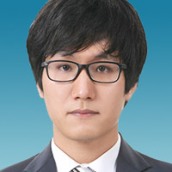





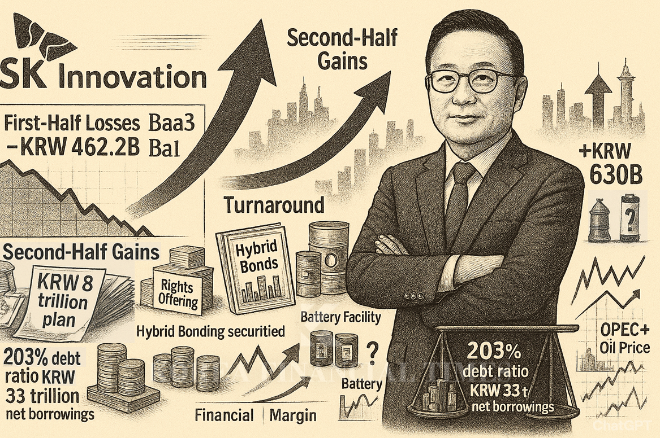
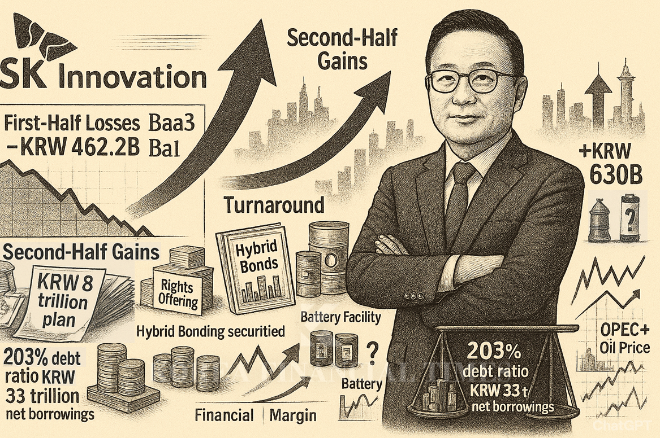
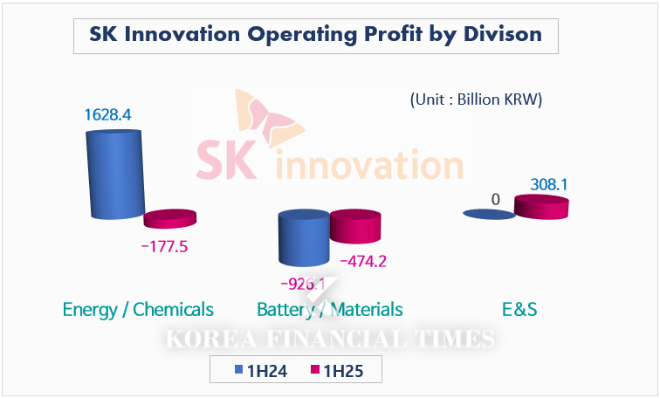
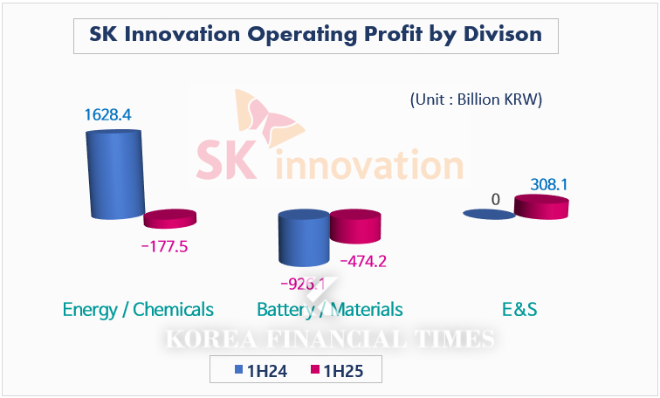






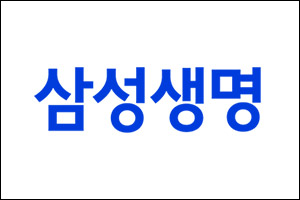








![[ECM] 연말 이어 연초까지…IPO 시장 '북적', 주관사도 '기지개'](https://cfnimage.commutil.kr/phpwas/restmb_setimgmake.php?pp=006&w=69&h=45&m=5&simg=2025111320592100145179ad439071182355207.jpg&nmt=18)
![강남·위례와 맞붙은 복정역 '에피트' 견본주택 가보니… [르포]](https://cfnimage.commutil.kr/phpwas/restmb_setimgmake.php?pp=006&w=69&h=45&m=5&simg=2025111416474806363048b718333211234196213.jpg&nmt=18)


![[DCM] 넷마블, 본업만 신용도 발목…더 주목받는 EB 발행](https://cfnimage.commutil.kr/phpwas/restmb_setimgmake.php?pp=006&w=69&h=45&m=5&simg=2025111404501304379a837df6494123820583.jpg&nmt=18)
![황병우號 iM뱅크, '시중은행 2막' 이끌 차기 리더는···강정훈·김기만 '물망' [2025 CEO 인사전망-iM금융]](https://cfnimage.commutil.kr/phpwas/restmb_setimgmake.php?pp=006&w=69&h=45&m=5&simg=2025111415030600919300bf52dd2121131180157.jpg&nmt=18)

![남궁원 하나생명 대표, 공격적 영업 매출 CSM 확대 성과…높은 연임 가능성 [2025 CEO 인사전망-하나금융]](https://cfnimage.commutil.kr/phpwas/restmb_setimgmake.php?pp=006&w=69&h=45&m=5&simg=2025042910033404253dd55077bc212411124362.jpg&nmt=18)
![송파구 ‘올림픽선수기자촌’ 46평, 1.8년 만에 14.75억 상승한 39.5억원에 거래 [아파트 신고가]](https://cfnimage.commutil.kr/phpwas/restmb_setimgmake.php?pp=006&w=69&h=45&m=5&simg=2025061908193804321e41d7fc6c2183101242202.jpg&nmt=18)
![강성묵 하나증권 대표, '키 맨'으로 비은행 강화 총력…지주-증권 역할 관건 [2025 CEO 인사 전망- 하나금융]](https://cfnimage.commutil.kr/phpwas/restmb_setimgmake.php?pp=006&w=69&h=45&m=5&simg=2025111214493308930179ad43907222110701.jpg&nmt=18)








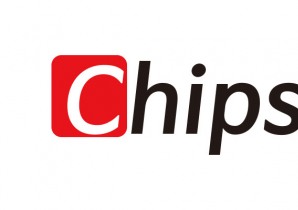
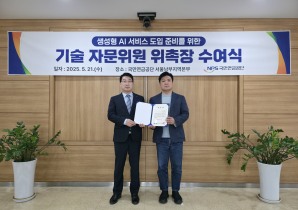


![[카드뉴스] KT&G, 제조 부문 명장 선발, 기술 리더 중심 본원적 경쟁력 강화](https://cfnimage.commutil.kr/phpwas/restmb_setimgmake.php?pp=006&w=298&h=298&m=1&simg=202509241142445913de68fcbb3512411124362_0.png&nmt=18)
![[카드뉴스] KT&G ‘Global Jr. Committee’, 조직문화 혁신 방안 제언](https://cfnimage.commutil.kr/phpwas/restmb_setimgmake.php?pp=006&w=298&h=298&m=1&simg=202503261121571288de68fcbb3512411124362_0.png&nmt=18)


![[카드뉴스] 국립생태원과 함께 환경보호 활동 강화하는 KT&G](https://cfnimage.commutil.kr/phpwas/restmb_setimgmake.php?pp=006&w=298&h=298&m=1&simg=202403221529138957c1c16452b0175114235199_0.png&nmt=18)
![[신간] 고수의 M&A 바이블](https://cfnimage.commutil.kr/phpwas/restmb_setimgmake.php?pp=006&w=81&h=123&m=5&simg=2025091008414900330f8caa4a5ce12411124362.jpg&nmt=18)
![[신간] 리빌딩 코리아 - 피크 코리아 극복을 위한 생산성 주도 성장 전략](https://cfnimage.commutil.kr/phpwas/restmb_setimgmake.php?pp=006&w=81&h=123&m=5&simg=2025032814555807705f8caa4a5ce12411124362.jpg&nmt=18)
![[서평] 추세 매매의 대가들...추세추종 투자전략의 대가 14인 인터뷰](https://cfnimage.commutil.kr/phpwas/restmb_setimgmake.php?pp=006&w=81&h=123&m=5&simg=2023102410444004986c1c16452b0175114235199.jpg&nmt=18)

![[신간] 조금 느려도 괜찮아...느림 속에서 발견한 마음의 빛깔](https://cfnimage.commutil.kr/phpwas/restmb_setimgmake.php?pp=006&w=81&h=123&m=5&simg=20251105082239062852a735e27af12411124362.jpg&nmt=18)

![[AD] 기아 ‘PV5’, 최대 적재중량 1회 충전 693km 주행 기네스 신기록](https://cfnimage.commutil.kr/phpwas/restmb_setimgmake.php?pp=006&w=89&h=45&m=1&simg=20251105115215067287492587736121125197123.jpg&nmt=18)
![[카드뉴스] KT&G, 제조 부문 명장 선발, 기술 리더 중심 본원적 경쟁력 강화](https://cfnimage.commutil.kr/phpwas/restmb_setimgmake.php?pp=006&w=89&h=45&m=1&simg=202509241142445913de68fcbb3512411124362_0.png&nmt=18)
![[AD]‘황금연휴에 즐기세요’ 기아, ‘미리 추석 페스타’ 이벤트 실시](https://cfnimage.commutil.kr/phpwas/restmb_setimgmake.php?pp=006&w=89&h=45&m=1&simg=20250903093618029117492587736121166140186.jpg&nmt=18)
![[AD]‘패밀리카 선두 주자’ 기아, ‘The 2026 카니발’ 출시](https://cfnimage.commutil.kr/phpwas/restmb_setimgmake.php?pp=006&w=89&h=45&m=1&simg=2025081810452407346749258773621116810840.jpg&nmt=18)
![[AD] ‘상품성↑가격↓’ 현대차, 2025년형 ‘아이오닉 5’·‘코나 일렉트릭’ 출시](https://cfnimage.commutil.kr/phpwas/restmb_setimgmake.php?pp=006&w=89&h=45&m=1&simg=202505131018360969274925877362115218260.jpg&nmt=18)



